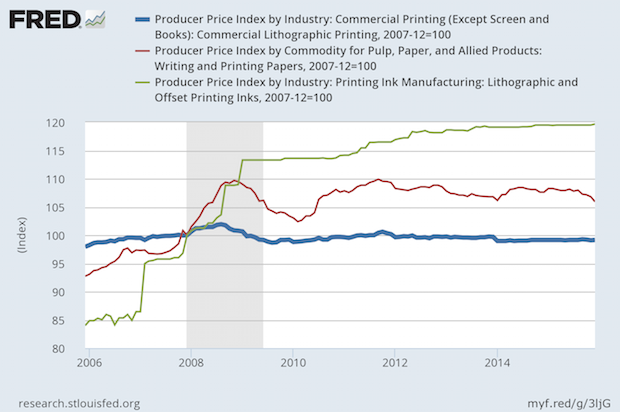
The Producer Price Index (PPI) does basically the same job for industrial materials that the Consumer Price Index (CPI) does for the goods we buy for ourselves.
Since December 2007, the base value (100) for this chart, the CPI is up by +12.6%. How have the PPI for commercial printing, ink, and paper changed? Commercial printing prices (blue line) are lower, -0.8%. This means that a commercial printing business has to increase its productivity and profitability to reward its owners and employees to make up for the loss of purchasing power they have in their paychecks.
There are many other factors, of course, but the prices of ink (green) have increased by +19.7% and paper (red) is up by +5.9%. These PPI categories are very large, but they offer a general picture of the situation.
If selling prices are not keeping up, and the prices of inputs are higher, what does one do? In addition to maintaining the purchasing power of wages and profits, the business must cover input cost increases.
First, it's a war on waste and spoilage, and reducing costs of managing the business.
Second, it's finding ways to more productive in what people do.
Third, it's investment in new equipment that produces at better costs.
There are many steps than management can take on the cost side, but as we know, adding new products and services can change the the way a business' economic engine operates.
It will be interesting to see how ink prices change in relation to the collapse of oil prices. Ink price decreases may take some time to appear because manufacturers often buy futures contracts on raw materials to ensure their supply and make their costs more predictable.
One thing we're not showing: the dramatic decreases in print alternatives and the increases in print distribution. It's a complex market, and print CEOs and leadership teams who know how to navigate it well and consistently are exceptional. They have to find ways to be smarter every day. You don't have to be a genius to be in the printing business, but it certainly helps.














